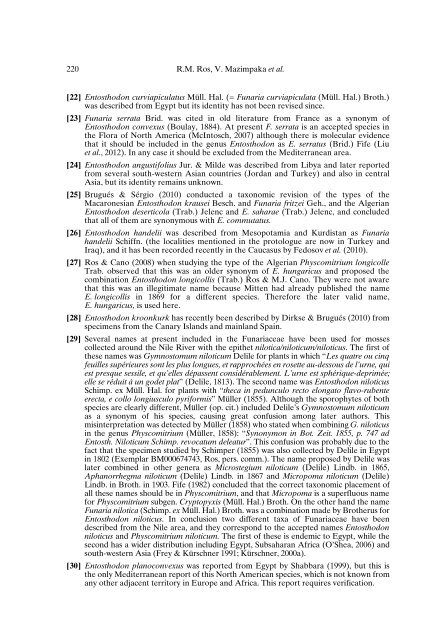Mosses of the Mediterranean, an annotated checklist - Optima-bot.org
Mosses of the Mediterranean, an annotated checklist - Optima-bot.org
Mosses of the Mediterranean, an annotated checklist - Optima-bot.org
Create successful ePaper yourself
Turn your PDF publications into a flip-book with our unique Google optimized e-Paper software.
220 R.M. Ros, V. Mazimpaka et al.[22] Entosthodon curviapiculatus Müll. Hal. (= Funaria curviapiculata (Müll. Hal.) Broth.)was described from Egypt but its identity has not been revised since.[23] Funaria serrata Brid. was cited in old literature from Fr<strong>an</strong>ce as a synonym <strong>of</strong>Entosthodon convexus (Boulay, 1884). At present F. serrata is <strong>an</strong> accepted species in<strong>the</strong> Flora <strong>of</strong> North America (McIntosch, 2007) although <strong>the</strong>re is molecular evidencethat it should be included in <strong>the</strong> genus Entosthodon as E. serratus (Brid.) Fife (Liuet al., 2012). In <strong>an</strong>y case it should be excluded from <strong>the</strong> <strong>Mediterr<strong>an</strong>e<strong>an</strong></strong> area.[24] Entosthodon <strong>an</strong>gustifolius Jur. & Milde was described from Libya <strong>an</strong>d later reportedfrom several south-western Asi<strong>an</strong> countries (Jord<strong>an</strong> <strong>an</strong>d Turkey) <strong>an</strong>d also in centralAsia, but its identity remains unknown.[25] Brugués & Sérgio (2010) conducted a taxonomic revision <strong>of</strong> <strong>the</strong> types <strong>of</strong> <strong>the</strong>Macaronesi<strong>an</strong> Entosthodon krausei Besch. <strong>an</strong>d Funaria fritzei Geh., <strong>an</strong>d <strong>the</strong> Algeri<strong>an</strong>Entosthodon deserticola (Trab.) Jelenc <strong>an</strong>d E. saharae (Trab.) Jelenc, <strong>an</strong>d concludedthat all <strong>of</strong> <strong>the</strong>m are synonymous with E. commutatus.[26] Entosthodon h<strong>an</strong>delii was described from Mesopotamia <strong>an</strong>d Kurdist<strong>an</strong> as Funariah<strong>an</strong>delii Schiffn. (<strong>the</strong> localities mentioned in <strong>the</strong> protologue are now in Turkey <strong>an</strong>dIraq), <strong>an</strong>d it has been recorded recently in <strong>the</strong> Caucasus by Fedosov et al. (2010).[27] Ros & C<strong>an</strong>o (2008) when studying <strong>the</strong> type <strong>of</strong> <strong>the</strong> Algeri<strong>an</strong> Physcomitrium longicolleTrab. observed that this was <strong>an</strong> older synonym <strong>of</strong> E. hungaricus <strong>an</strong>d proposed <strong>the</strong>combination Entosthodon longicollis (Trab.) Ros & M.J. C<strong>an</strong>o. They were not awarethat this was <strong>an</strong> illegitimate name because Mitten had already published <strong>the</strong> nameE. longicollis in 1869 for a different species. Therefore <strong>the</strong> later valid name,E. hungaricus, is used here.[28] Entosthodon kroonkurk has recently been described by Dirkse & Brugués (2010) fromspecimens from <strong>the</strong> C<strong>an</strong>ary Isl<strong>an</strong>ds <strong>an</strong>d mainl<strong>an</strong>d Spain.[29] Several names at present included in <strong>the</strong> Funariaceae have been used for mossescollected around <strong>the</strong> Nile River with <strong>the</strong> epi<strong>the</strong>t nilotica/niloticum/niloticus. The first <strong>of</strong><strong>the</strong>se names was Gymnostomum niloticum Delile for pl<strong>an</strong>ts in which “Les quatre ou cinqfeuilles supérieures sont les plus longues, et rapprochées en rosette au-dessous de l’urne, quiest presque sessile, et qu’elles dépassent considérablement. L’urne est sphérique-deprimée;elle se réduit à un godet plat” (Delile, 1813). The second name was Entosthodon niloticusSchimp. ex Müll. Hal. for pl<strong>an</strong>ts with “<strong>the</strong>ca in pedunculo recto elongato flavo-rubenteerecta, e collo longiusculo pyriformis” Müller (1855). Although <strong>the</strong> sporophytes <strong>of</strong> <strong>bot</strong>hspecies are clearly different, Müller (op. cit.) included Delile’s Gymnostomum niloticumas a synonym <strong>of</strong> his species, causing great confusion among later authors. Thismisinterpretation was detected by Müller (1858) who stated when combining G. niloticusin <strong>the</strong> genus Physcomitrium (Müller, 1858): “Synonymon in Bot. Zeit. 1855, p. 747 adEntosth. Niloticum Schimp. revocatum deleatur”. This confusion was probably due to <strong>the</strong>fact that <strong>the</strong> specimen studied by Schimper (1855) was also collected by Delile in Egyptin 1802 (Exemplar BM000674743, Ros, pers. comm.). The name proposed by Delile waslater combined in o<strong>the</strong>r genera as Microstegium niloticum (Delile) Lindb. in 1865,Aph<strong>an</strong>orrhegma niloticum (Delile) Lindb. in 1867 <strong>an</strong>d Micropoma niloticum (Delile)Lindb. in Broth. in 1903. Fife (1982) concluded that <strong>the</strong> correct taxonomic placement <strong>of</strong>all <strong>the</strong>se names should be in Physcomitrium, <strong>an</strong>d that Micropoma is a superfluous namefor Physcomitrium subgen. Cryptopyxis (Müll. Hal.) Broth. On <strong>the</strong> o<strong>the</strong>r h<strong>an</strong>d <strong>the</strong> nameFunaria nilotica (Schimp. ex Müll. Hal.) Broth. was a combination made by Bro<strong>the</strong>rus forEntosthodon niloticus. In conclusion two different taxa <strong>of</strong> Funariaceae have beendescribed from <strong>the</strong> Nile area, <strong>an</strong>d <strong>the</strong>y correspond to <strong>the</strong> accepted names Entosthodonniloticus <strong>an</strong>d Physcomitrium niloticum. The first <strong>of</strong> <strong>the</strong>se is endemic to Egypt, while <strong>the</strong>second has a wider distribution including Egypt, Subsahar<strong>an</strong> Africa (O’Shea, 2006) <strong>an</strong>dsouth-western Asia (Frey & Kürschner 1991; Kürschner, 2000a).[30] Entosthodon pl<strong>an</strong>oconvexus was reported from Egypt by Shabbara (1999), but this is<strong>the</strong> only <strong>Mediterr<strong>an</strong>e<strong>an</strong></strong> report <strong>of</strong> this North Americ<strong>an</strong> species, which is not known from<strong>an</strong>y o<strong>the</strong>r adjacent territory in Europe <strong>an</strong>d Africa. This report requires verification.






